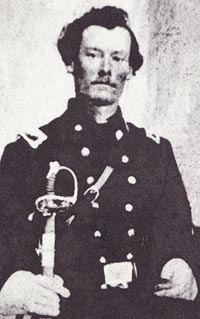I really don't like unanswered questions. However, delving
into the murky past provides me with scores, nay, hundreds of unanswered
questions. Writing the book on the
Branch-Lane brigade is no exception. I would still like to know what flag was
issued to the brigade on the eve of the Seven Days campaign. I'd still like to
know just how far to the left the 33rd NC was at the battle of Second Manassas.
Just why did Lane and some of his lieutenants go into the fight on the
afternoon of May 12, 1864, unarmed? Maybe in time, I will find these answers.
Nevertheless, this project is just about finished for me.
Of course, there are several instances where I have made
some pretty good finds - like information on the role of the brigade on day two
at Gettysburg, and Lane's personal observation about Appomattox. Some really
good stuff you will not find in other places.
There is, however, one piece I am still seeking: James H.
Lane's pardon.
Lane wrote his letter on July 10, 1865, from Matthews
County, Virginia, the home of his parents. The letter is short, just one page.
"I respectfully make application for pardon under your
amnesty proclamation of May 29, 1863, and ask to be restored to all the rights
of a citizen of the United States. I entered the Confederate service from the
State of North Carolina, and served as a Brigadier General in the Provisional
Army of the Confederate States from the 1st of November 1862 to the surrender
of the Army of Northern Virginia. I am without property and without money. My
address is Norfolk, Va Care of Mr. William R. Hudgins."
There is just one other piece - on July 11, 1865, Lane went
before the provost marshal and took the Oath of Allegiance. Missing is the date
Lane was granted his pardon.
 |
| Lane, post-war, with cloth covering the buttons on his Confederate coat. |
In trying to find Lane's pardon, I came across an article
entitled "The Soldier's Burden: A Study of North Carolina Confederate
Officer Request for Amnesty." According to the article, US President
Andrew Johnson issued a Proclamation of Amnesty and Reconstruction on May 29,
1865. Former Confederate soldiers were all pardoned, unless they fell into one
of fourteen classes. Lane, serving as a brigadier general, was excluded and had
to write the president, through the governor, asking to be pardoned. Lane
should have sent his letter to North Carolina governor W. W. Holden, although
nothing in the file indicates this.
There were thousands of applications that flooded into
Washington City. Johnson was slow on pardoning Confederate officers. While
there does not appear to be evidence that Lane ever did, other former
Confederate officers frequently wrote friends in Washington City, inquiring
about their application and asking for intervention.
President Johnson, in an attempt to speed up Reconstruction,
pardoned all but men who fell into three classes on September 7, 1867. Men who
had served as Confederate brigadier generals were still in the unpardoned
class. On July 4, 1868, Johnson granted amnesty to all former Confederates,
except a group of 300, who were under indictment in United States courts under
the charge of treason or other felonies. Johnson issued his final mass pardon
on December 25, 1868.
As far as I can tell, James H. Lane should have been pardoned
on July 4, 1868. I've not found where he was under indictment, although he was
once arrested and imprisoned at Fortress Monroe for incendiary speech. He was
later released when it was discovered it was another man named Lane making the
remarks.
But then again, I don't having anything that actually says Lane
was pardoned on July 4, 1868. The search goes on.....








